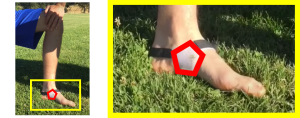Author’s Note: This post is one in a series of posts that breaks down the 2010 Soccer MVP Tournament competition. Be sure to look at the final results to review how ‘Inside’ was crowned champion. What do you call this part of the foot? Please vote.
I am witnessing a nice evolution in the youth soccer of today. More and more coaching philosophies are professing and emphasizing that players become more creative. This is being applied and fostered by encouraging players to dribble. Many young players know the names of the popular moves that were introduced and perfected by some of the world’s best professionals. They include:
- The Cruyff turn
- The Zidane spin move
- The Puskas pullback (50 seconds into this great tribute to Puskas)
- The Rivelino reverse scissors
- Ronaldo’s inside swerve
Working on these skills in practice, at home, incorporating them into small-sided practice games, and executing them in real games are making our youth players much more creative. This is fantastic!
For this discipline, dribbling was broken down into two categories: speed and moves. ‘Laces’ was the overwhelming winner for speed, with ‘Inside’ and ‘Outside’ sharing second place. When it came to moves, which consisted of fakes and feints to get around an opponent, ‘Inside’ and ‘Outside’ shared the top spot.
Speed
There are two types of speed in soccer: speed off the ball and speed with the ball. The fastest players on a team should be the fastest players off the ball. However, the fastest players are not always the fastest dribblers. Proper dribbling technique plays a huge part in the overall speed of a dribbler.
Good running form requires that the toes are always pointing in the direction the player is running in. To achieve optimal dribbling speed, a player should deviate his/her running form as little as possible. The easiest way to accomplish this while controlling the ball is to use the top-of-the-foot. Touching the ball with the top-of-the-foot requires only the slightest change in form. When done probably, only very little speed has to be lost.
The toe could also be used to touch the ball when speed is critical. In fact, using the toe to dribble deviates even less than using the top-of-the-foot. However, because the toe surface is rounded, a player will have less ball control when it is touched. The top-of-the-foot is much flatter and provides much more control.
Because the angle of the foot has to change when touching a ball with the inside- or outside-of-the-foot, a player’s running form will change and overall speed will be reduced. Playing a ball with the bottom-of-the-foot and sustaining any kind of speed is impossible.
Moves
Dribbling around a player is best achieved using the inside- or outside-of-the-foot. All of the moves listed above use one of these parts. In fact, you may have noticed that to accomplish these moves, the players used a combination of surfaces to complete the moves. This is typical in order to beat good defenders. Sometimes, the bottom-of-the-foot is incorporated into these moves as well.
Rarely is the top-of-the-foot used to get around an opponent. Because of its flat surface and the position of the foot when a ball is played with this part of the foot, the ball will naturally go straight. With an opponent directly in front of a player, this serves no value. However, it is worth mentioning that at full speed, using the toe to poke the ball past a defender is a great move. Since I am lumping the toe together with the top-of-the-foot, ‘Laces’ and ‘Bottom’ share the same score.
Conclusion
It turns out that the dribbling discipline was too close to call. Though ‘Inside’ and ‘Outside’ fared very well in both dribbling categories, because ‘Laces’ was such an overwhelming winner in the speed category, all three surfaces took first place.
The other disciplines evaluated in this competition were: structure, receiving, passing, shooting, popularity among professionals, and ease of learning.

